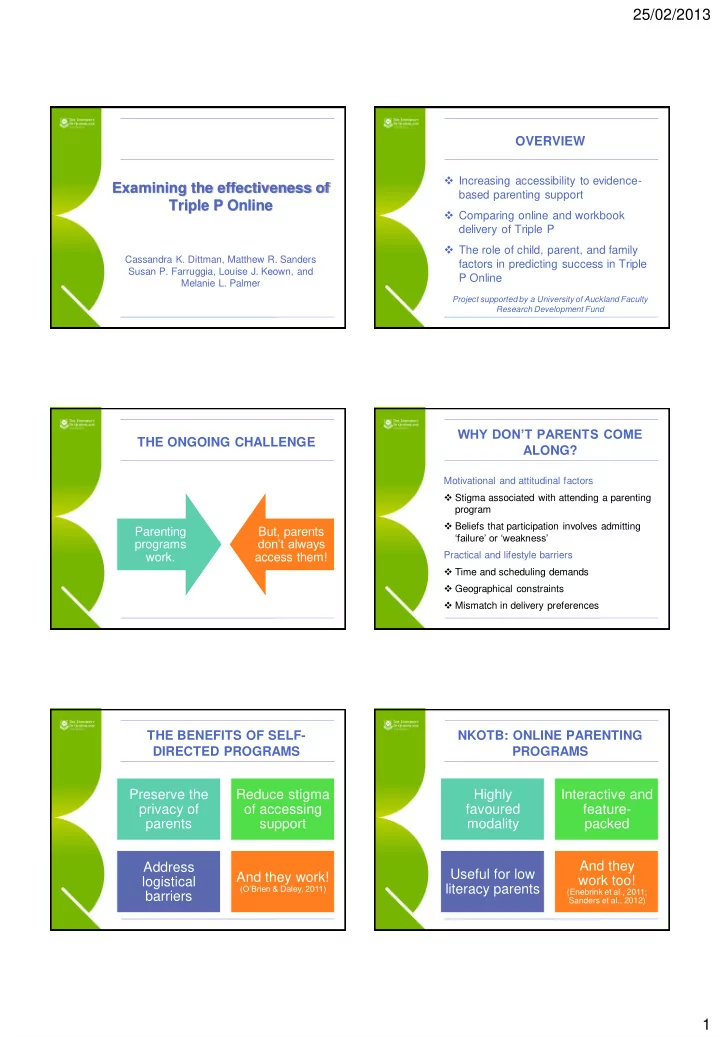

25/02/2013 OVERVIEW Increasing accessibility to evidence- Examining the effectiveness of based parenting support Triple P Online Comparing online and workbook delivery of Triple P The role of child, parent, and family Cassandra K. Dittman, Matthew R. Sanders factors in predicting success in Triple Susan P. Farruggia, Louise J. Keown, and P Online Melanie L. Palmer Project supported by a University of Auckland Faculty Research Development Fund Name of presentation Month 2009 Name of presentation Month 2009 WHY DON’T PARENTS COME THE ONGOING CHALLENGE ALONG? Motivational and attitudinal factors Stigma associated with attending a parenting program Beliefs that participation involves admitting Parenting But, parents ‘failure’ or ‘weakness’ don’t always programs Practical and lifestyle barriers work. access them! Time and scheduling demands Geographical constraints Mismatch in delivery preferences Name of presentation Month 2009 Name of presentation Month 2009 THE BENEFITS OF SELF- NKOTB: ONLINE PARENTING DIRECTED PROGRAMS PROGRAMS Preserve the Reduce stigma Highly Interactive and privacy of of accessing favoured feature- parents support modality packed Address And they Useful for low And they work! work too! logistical literacy parents (O’Brien & Daley, 2011) (Enebrink et al., 2011; barriers Sanders et al., 2012) Name of presentation Month 2009 Name of presentation Month 2009 1
25/02/2013 THE NONINFERIORITY THE CURRENT PROJECT RESEARCH DESIGN A head-to-head comparison of the new Triple Null hypothesis = TPOL is inferior to the P Online with the existing Every Parent’s Self - workbook by at least a prespecified and Help Workbook empirically-derived noninferiority margin Alternative hypothesis = TPOL is inferior to Noninferiority RCT comparing effects on child the workbook by less than the noninferiority behaviour and parenting margin Also examined effects of each intervention on Noninferiority margin a number of child, parenting, and family • Derived from past RCT on the workbook outcomes at post-intervention and 6-month • Cohen’s d = 0.20 follow up Name of presentation Month 2009 Name of presentation Month 2009 THE TRIPLE P SYSTEM OF PARTICIPANTS INTERVENTION Breadth of reach N = 192 (TPOL = 97, Workbook = 95) Recruited from around New Zealand Level 1 Target child Media & communication strategy Intensity of intervention • 3 to 8 years (mean = 5.64 years) • 67% male, 33% female Brief parenting advice Level 2 • 87% with clinical level conduct problems Families Level 3 Narrow focus parenting support • Mothers’ mean age = 37.19 years; fathers’ mean age = 39.63 years • Level 4 77% two-parent biological; 14% sole-parent; Broad focus parenting support 7% step-family • 83% completed high school, 47% university Level 5 Intensive family intervention educated Name of presentation Month 2009 THE INTERVENTION CONDITIONS Every Parent’s Self -Directed Workbook • 10-module program involving readings, exercises, and structured practice sessions Triple P Online • Designed to be highly interactive and engaging • User-friendly interface and navigation • Audiovisual presentation of information and strategies • Goal-setting and exercises for checking mastery • Downloadable tipsheets, monitoring forms, podcasts • Customisable and printable parent workbook • Review and reminder strategies Name of presentation Month 2009 Name of presentation Month 2009 2
25/02/2013 PRE-POST IMPROVEMENT: PRE-POST IMPROVEMENT: ECBI-INTENSITY ECBI-PROBLEM 45 12 40 10 35 30 8 25 6 20 15 4 d = -.09 d = -.16 d = -.13 d = -.14 10 2 5 0 0 Mothers Fathers Mothers Fathers Workbook Triple P Online Workbook Triple P Online Name of presentation Month 2009 Name of presentation Month 2009 TPOL: SHORT-TERM EFFECTS PRE-POST IMPROVEMENT: FOR MOTHERS I PARENTING SCALE (OVR) Pre Post Effect size Descriptor M (SD) M (SD) d 1.2 ECBI Intensity 155.60 (20.71) 114.17 (23.77) Large 1.54 1 Large ECBI Problem 22.40 (5.80) 10.92 (7.50) 1.44 0.8 Over-reactivity 3.61 (0.77) 2.57 (0.77) 1.29 Large 0.6 Laxness 2.79 (0.81) 2.16 (0.80) 1.00 Large 0.4 d = -.03 d = .05 0.2 Verbosity 3.73 (0.79) 2.73 (0.91) 1.06 Large 0 Setting Self 79.10 (10.25) 90.46 (7.07) -1.27 Large Mothers Fathers Efficacy Workbook Triple P Online Behaviour Self 67.75 (14.07) 86.20 (11.85) -1.38 Large Efficacy Name of presentation Month 2009 TPOL: SHORT-TERM EFFECTS PRELIMINARY CONCLUSIONS FOR MOTHERS II Pre Post Effect size Descriptor M (SD) M (SD) d 1. Triple P Online is effective when compared Parental Anger 124.10 (29.70) 111.62 (35.23) Small 0.46 to a waitlist control (Sanders et al., 2012) Child Abuse 5.13 (4.03) 3.56 (3.34) 0.49 Small 2. Triple P Online is not inferior (equivalent) in Risk its effectiveness to the Every Family Depression 5.23 (6.03) 3.52 (5.36) 0.27 Small workbook Anxiety 2.86 (4.23) 1.65 (2.78) 0.38 Small • Comparable effectiveness of both programs = choice for parents and Stress 11.91 (6.87) 6.90 (5.67) 0.66 Medium services Interparental 5.24 (3.54) 3.34 (2.50) 0.66 Medium • Highlights the value of the noninferiority Conflict approach Parent Child 41.08 (7.00) 52.51 (6.44) -1.49 Large Relationship Name of presentation Month 2009 3
25/02/2013 WHAT PREDICTS TPOL PRELIMINARY CONCLUSIONS CHILD BEHAVIOUR OUTCOMES? Significant No predictive BUT… predictors association • Session • Family SES Is Triple P Online effective for families: completion ( β = - factors • from diverse SES backgrounds? .33) • Child factors • T1 parent-child • T1 child behaviour • with high levels of child behaviour relationship quality severity problems? ( β = -.24) • T1 level of parenting difficulty • Father involvement Name of presentation Month 2009 Name of presentation Month 2009 WHAT PREDICTS TPOL IMPLICATIONS & PARENTING OUTCOMES? CONSIDERATIONS Significant No predictive Well-established family and child risk factors predictors association may not have a large influence on success in • Session • Family SES online parenting programs completion ( β = factors Points to the importance of identifying and -.41) • Child factors testing strategies to maximise retention • T1 ineffective • T1 child Possible strategies: parenting ( β = behaviour • Adjunctive professional support (e.g., by .47) severity telephone, Skype, or online messaging), • Father • Peer support via social networking involvement • Moving beyond ‘grandfather machines’ Name of presentation Month 2009 Name of presentation Month 2009 4
Recommend
More recommend